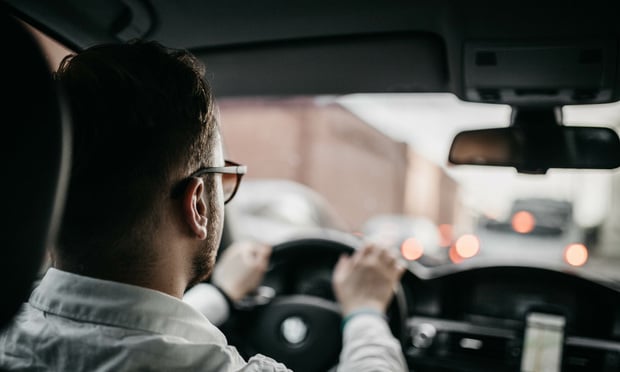Flooding has devasted many areas of the United States over the past few years, creating enormous damage to properties and thousands of vehicles.
Flood-damaged vehicles offer a tempting opportunity for criminals to defraud unsuspecting consumers.
Carfax research recently revealed Americans are driving more than a quarter-million flood damaged cars. Carfax estimates that more than 50 percent of water-damaged cars get resold.
Fraud involving used vehicles damaged by storm flooding that later appear in used car lots and auction sales is common, according to the Insurance Information Institute.
In some states, vehicles that have been flooded bear the words “salvage only” on their titles, usually after damage to the vehicle has reached about 75 percent of its value.
Howerver, if the vehicle’s owner doesn’t have comprehensive insurance coverage at the time, or the repair bill didn’t exceed a certain amount, the vehicle might not get a ‘salvage’ or branded title at all.
|Title washing
Unscrupulous sellers may also switch or clone manufacturers’ serial number plates and put them on a flooded vehicle that has been repaired. They may also resell a car that has a salvage title in a state that has more lax title standards. This practice is called “title washing.”
In recent years, some states in the hurricane-prone parts of the United States have adopted rules that require that the words “flood vehicle” be included on the titles of vehicles that have been water damaged and rebuilt. Before such a vehicle can be sold, the buyer must be notified in writing of the vehicle’s past flood damage. However, if another state doesn't have such strict laws, it can become a dumping ground for undeclared flooded vehicles.
Here's important information and tips for insurance agents and their clients to avoid being victimized by flood vehicle fraud:
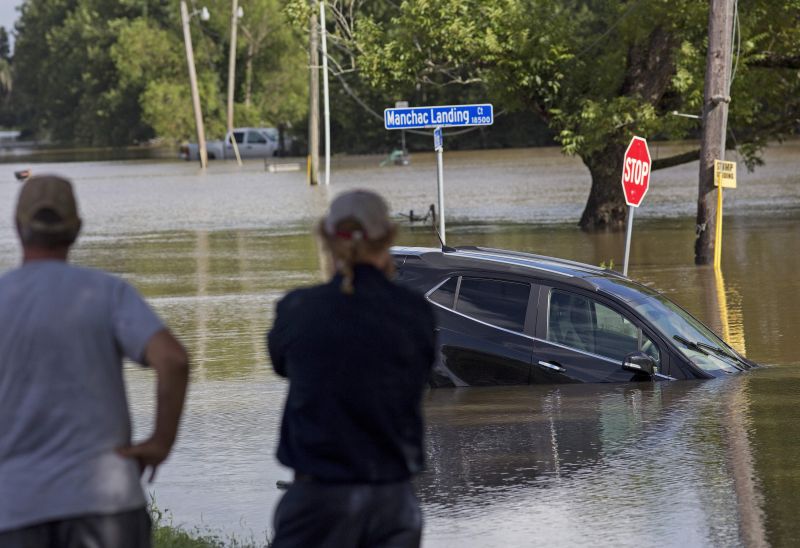
Residents survey the flood water on Old Jefferson Highway at Bayou Manchac in Prairieville, La., on Aug. 16. (Photo:Max Becherer/AP Photo)
|'Flood vehicle' definition
By definition, a flood vehicle has been completely or partially submerged in water to the extent that its body, engine, transmission or other mechanical component parts have been damaged. If the vehicle is so damaged that it is no longer operable, the driver's insurance company settles the claim by buying the vehicle and selling it as a “salvage” at an auto auction, according to the National Insurance Crime Bureau.
After the hurricanes of 2005, the NICB created a database in which vehicle identification numbers and boat hull identification numbers from flooded vehicles and boats are stored and made available to law enforcers, state fraud bureaus, insurers and state departments of motor vehicles. The database (VINcheck) is online and can be accessed by the general public.
Another attempt to solve the problem of title washing is the National Motor Vehicle Title Information System, a database that requires junk and salvage yard operators and insurance companies to file monthly reports on vehicles declared total losses. The program operates under the auspices of the U.S. Department of Justice and is administered by the American Association of Motor Vehicle Administrators.
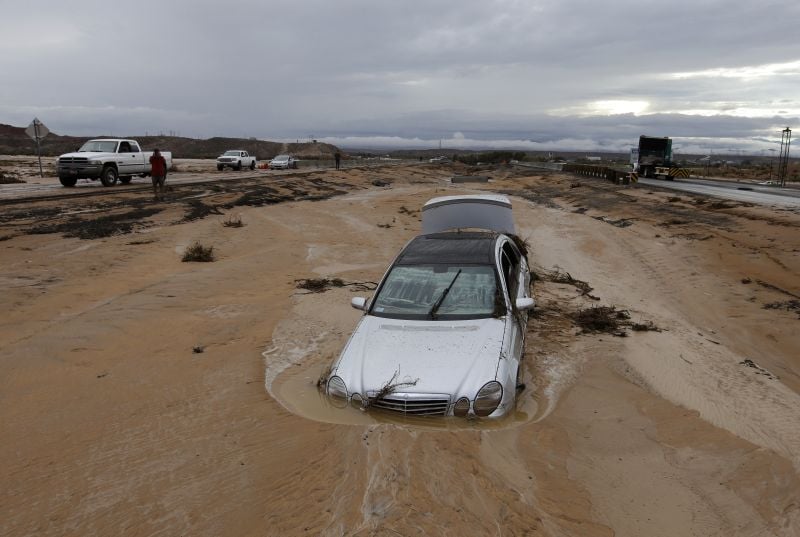
A car is partially buried in mud on Interstate 15 in Moapa, Nev., on Sept. 8, 2014. (Photo: John Locher/AP Photo)
|Hiding flood damage
Dishonest car dealers buy water-damaged vehicles, dry and clean them, yet leave plenty of hidden flood damage. They then transport the vehicles to states unaffected by the storm or natural disaster and sell them as used vehicles to unsuspecting buyers.
Flood damage can ruin a vehicle in any number of ways, from eating away the electronics wiring to seizing up mechanical systems, and the damage may not reveal itself for months or even years. Corrosion and rust often eat away at the vehicle's metal and components from the inside out, according to AutoTrader.
Recent 2016 data from Carfax suggests that more than 271,000 cars reported as flood damaged by a state’s Department of Motor Vehicles, insurance companies and others, are back in use. It’s a nearly 30 percent increase from 2013.
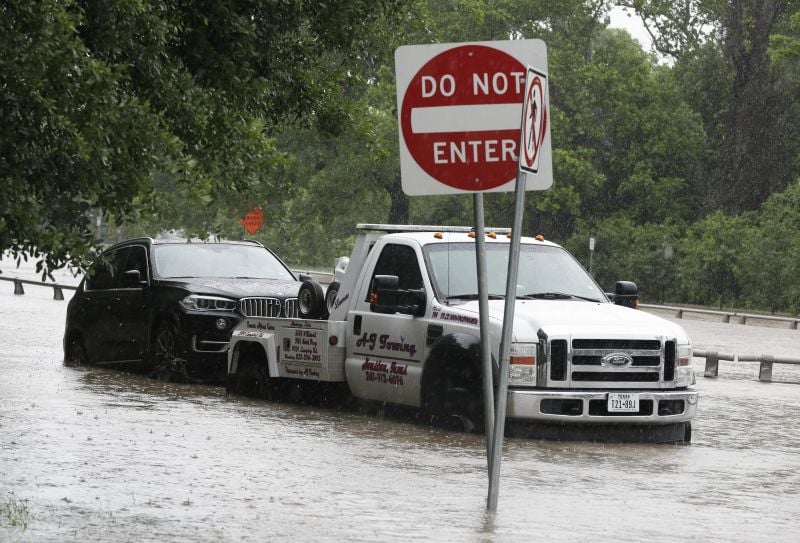
In this April 18 file photo, a stranded vehicle is towed out of a flooded street in Houston. (Photo: Pat Sullivan/AP Photo)
|Know the signs of vehicle flood damage
- Water stains and mildew mean the vehicle may have gone for a swim.
- A musty odor in the interior, which can sometimes be covered with a strong air-freshener.
- Upholstery or carpeting which is loose, new, stained or doesn’t match. Brand-new carpets in an older vehicle can be an important red flag.
- Damp carpets.
- Rust around doors, under the dashboard, on the pedals or inside the hood and trunk latches.
- Mud or silt in the glove compartment or under the seats.
- Brittle wires under the dashboard.
- Fog or moisture beads in the interior lights, exterior lights or instrument panel.
Related: How insurance agents can counsel clients after a flood

A sedan sits underwater along Shaw Street in Drew, Miss., on March 11 as floodwaters have affected areas in the Delta. (Photo: Rogelio V. Solis/AP Photo)
|Checklist for evaluating a vehicle for flood damage
- Turn on the ignition and check all instrument panel lights illuminate.
- Test the interior and exterior lights, air conditioning, windshield wipers, radio, turn signals and heater repeatedly.
- Check the seat-mounting screws to see if there is any evidence that they have been removed. To dry the carpets effectively, the seats must be removed and possibly even replaced.
- Look at the heads of any unpainted, exposed screws under the dashboard. Unpainted metal in flood cars will show signs of rust.
- Check if the rubber drain plugs under the car and on the bottom of doors look as if they have been removed recently. It may have been done to drain floodwater.
- Check inside the seatbelt retractors by pulling the seatbelt all the way out and inspect for moisture, mildew or grime.
- Check door speakers as they will often be damaged because of flooding.
- Check aluminum and alloys for a white powder and pitting.
- Under the hood, check the engine oil by pulling the dipstick. When oil mixes with even a small amount of water it becomes murky, like a melted chocolate milkshake.
- Inspect the paper air filter. If the filter shows signs of water stains you will want to keep looking for another vehicle.
- Don’t forget to check the trunk. Take out the spare tire and check for moisture or sitting water.
- Take a lengthy test drive. A part of your test drive should include testing the vehicle’s electrical systems, as they are prone to water damage.
- |
- |
- When you start the car, do you notice any smoke or odd smells?
- Listen for irregular noises, such as strained warning buzzers.
- Try every accessory to see if it works properly, including turn signals, windshield wipers, headlight switches and high beams
- Turn on the vehicle's entertainment system and listen to the audio.
- |
- Get the car checked thoroughly by a trusted mechanic.
- Carfax offers a free flood damage check, in addition to its for-pay vehicle history reports.
- Trust your instincts: If you don’t like the answers or the deal sounds too good to be true, walk away.
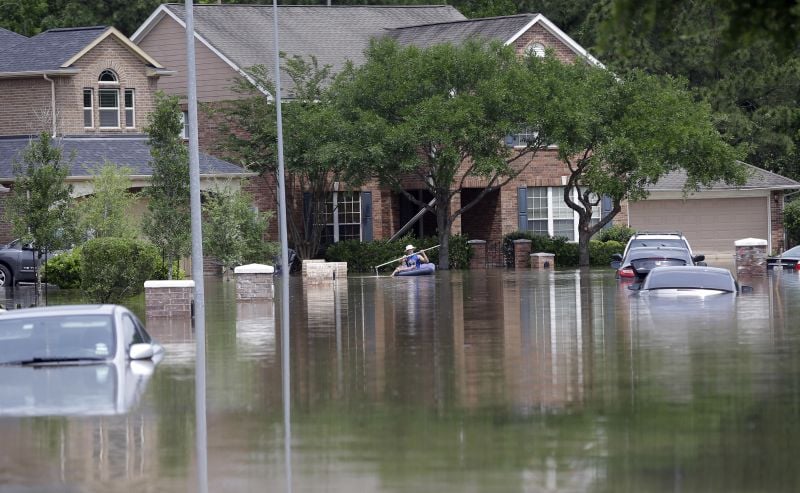
A person paddles through a flooded neighborhood on April 19 in Spring, Texas. Storms dumped more than a foot of rain in the Houston area, flooding dozens of neighborhoods. (Photo: David J. Phillip/AP Photo)
|10 states that have the most previously flooded vehicles in 2016
1. Texas (43,000).
2. Pennsylvania (20,000).
3. Florida (17,000).
4. Kentucky (14,000).
5. Illinois (13,000).
6. South Carolina (11,000).
7. Michigan (11,000).
8. New Jersey (10,000).
9. New York (9,000).
10. Louisiana (9,000).
(Source: Carfax)
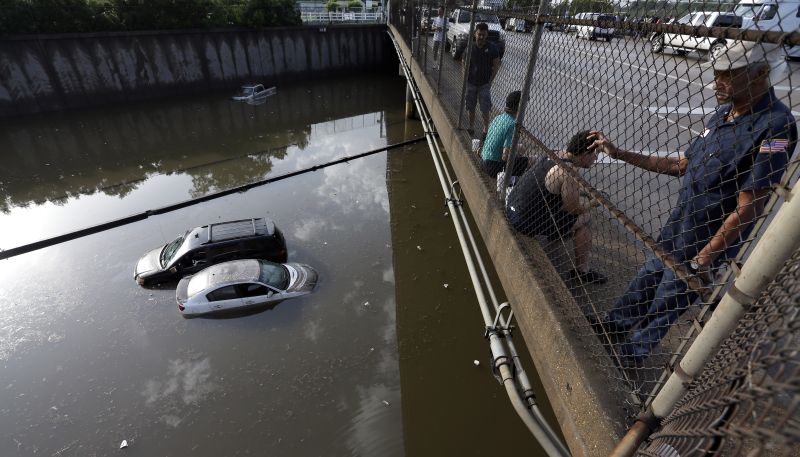
In this May 29, 2015, file photo, cars sit in floodwaters along Interstate 45 after heavy overnight rain flooded parts of the highway in Houston. (Photo: David J. Phillip/AP Photo)
|Top 10 cities with flooded cars in 2016
1. Houston (19,314).
2. New York (15,722).
3. Philadelphia (11,998).
4. Dallas/Fort Worth (9,896).
5. Chicago (9,524).
6. Miami/Fort Lauderdale (8,407).
7. Detroit (7,156).
8. Minneapolis/St. Paul (6,332).
9. Boston (4,283).
10. Pittsburgh (3,751).
(Source: Carfax)

Cars sit submerged in flood waters on Tallapoosa Street on Dec. 25, 2015, in Birmingham, Ala. (Photo: Butch Dill/AP Photo)
|Additional fraud prevention tips
- Buy only from a reputable dealer/seller.
- Ask good questions. Specifically inquire if the vehicle was ever damaged in a flood. Whatever the answer, get it in writing with the bill of sale if you buy the car.
- Ask to see the vehicle's title. If you think the vehicle was damaged in a flood and the title is not stamped "salvage" or "flood," ask for the car's history to see if it came from a state that recently experienced flooding.
Related:
Want to continue reading?
Become a Free PropertyCasualty360 Digital Reader
Your access to unlimited PropertyCasualty360 content isn’t changing.
Once you are an ALM digital member, you’ll receive:
- Breaking insurance news and analysis, on-site and via our newsletters and custom alerts
- Weekly Insurance Speak podcast featuring exclusive interviews with industry leaders
- Educational webcasts, white papers, and ebooks from industry thought leaders
- Critical converage of the employee benefits and financial advisory markets on our other ALM sites, BenefitsPRO and ThinkAdvisor
Already have an account? Sign In Now
© 2024 ALM Global, LLC, All Rights Reserved. Request academic re-use from www.copyright.com. All other uses, submit a request to [email protected]. For more information visit Asset & Logo Licensing.



